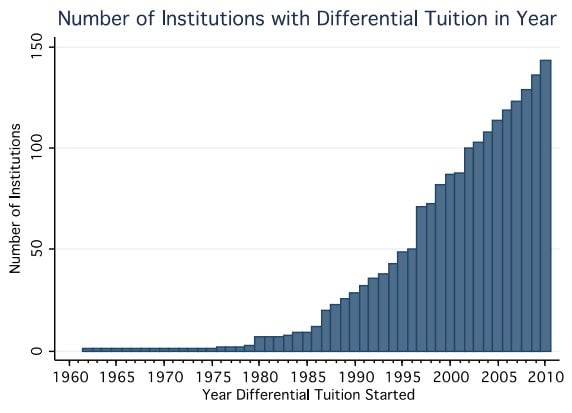Should US colleges charge engineers more than English majors?
Imagine opening a restaurant menu and finding that every dish, from the steak frites to the frisse salad, costs $14.99. It would seem odd, right? After all, buying and cooking a ribeye is more expensive than throwing some lettuce in a bowl. Charging the same for each wouldn’t make sense.


Imagine opening a restaurant menu and finding that every dish, from the steak frites to the frisse salad, costs $14.99. It would seem odd, right? After all, buying and cooking a ribeye is more expensive than throwing some lettuce in a bowl. Charging the same for each wouldn’t make sense.
Yet, that’s pretty much how most colleges price their majors. Undergrads pay the same flat rate per credit no matter what they study, even though different courses can require vastly different resources to teach. Giant freshman lectures are cheaper to run per-student than intimate senior seminars, and reading-heavy majors like history are cheaper than lab-oriented disciplines like biology. At New York’s state colleges, to give one real-world example, advanced engineering or hard science courses cost more than five times as much to teach than low-level psychology classes. None of this tends to be reflected on tuition bills.
Should it? Would colleges, or students, be better off if higher ed finally nixed one price fits all?
This week, University of Michigan economist Kevin Stange released a new working paper that illustrates what one of the potential downsides of doing so might be. Over the last two decades, a growing minority of schools have in fact experimented with varying tuition by major. A Cornell study (which produced the graph below) found that 41 percent of public doctoral universities have tried charging a premium for at least one program — usually engineering, business, or nursing. Looking at a sample of these schools, Stange’s paper concludes that raising the price of certain majors seems to influence what students choose to study, though not always in predictable ways.

In the case of engineering, raising the price of a degree by 14.5 percent was associated with a 7 percent point drop in the share of degrees schools awarded in the field. Meanwhile, a 19 percent increase in the price of a nursing degree led to an 18 percent rise in degree share*—though, for reasons having to do with the statistical calculations, the true jump might well have been smaller.
Why price hikes reduced the number of engineers but increased the number of nurses is a bit of a puzzle. The study tries to control for the influence of the job market by comparing schools that varied their tuition against those that did not, meaning that the boom in healthcare jobs shouldn’t have been an issue. As Stange notes, it may be that some colleges took the extra revenue and reinvested in their nursing programs, which led to higher enrollment. But in the end, the cause isn’t clear.
Nonetheless, Stange’s findings seem to confirm a notion that will sit uncomfortably with many educators: varying prices by major might dissuade students from pursuing their academic interests, even if they’re geared towards lucrative fields like the sciences, where the eventual payoff from a degree would almost certainly outstrip the extra tuition dollars. Worse yet, in the case of engineering, low-income Pell Grant recipients had the strongest reaction to price hikes. In other words, many colleges essentially seem to be pushing poor students away from one of the most financially rewarding majors.
Some might see a plus side here. Florida governor Rick Scott, for instance, has advocated tuition discounts for students studying high-tech, high-demand fields, in order to encourage more to undergrads to pursue them. But that doesn’t appear to be an idea that is being pursued in most states, and it could bring on its own problems.
So does this mean that we should leave one-price-fits-all as is? Not necessarily. Rather than charging based on field of study, there’s still the option of charging students based on course level, since, again, upper level classes tend to be more expensive to run. I’m not about to roll out a full policy proposal at the moment. But there are a couple of reasons to think it wouldn’t be a bad idea to charge seniors more than freshmen. Right now, students who take a few intro level courses and then drop out—of which there are depressingly many—subsidize students who take costlier, higher-level courses on route to a degree, and a better paycheck. Charging students less early on and more down the line would fix that imbalance. Beyond that, since some studies have suggested that the cost of school also influences completion, charging by course level might also help keep students in school through the crucial early years of higher education.
It’s just a thought. But in any event, there’s got to be a better system than charging the same price for steak and salad.
__________________________
*UPDATE JULY 4: For the sake of simplicity, I rewrote this section using percentages rather than percentage points. In the paper, it showed a 1.1 percentage point drop in engineering degrees awarded from an average 14.7 percent share. In nursing, it was a .8 percentage point rise from a 4.4 percent average share.
Jordan Weissmann is an associate editor at The Atlantic. He has written for a number of publications, including The Washington Post and The National Law Journal.